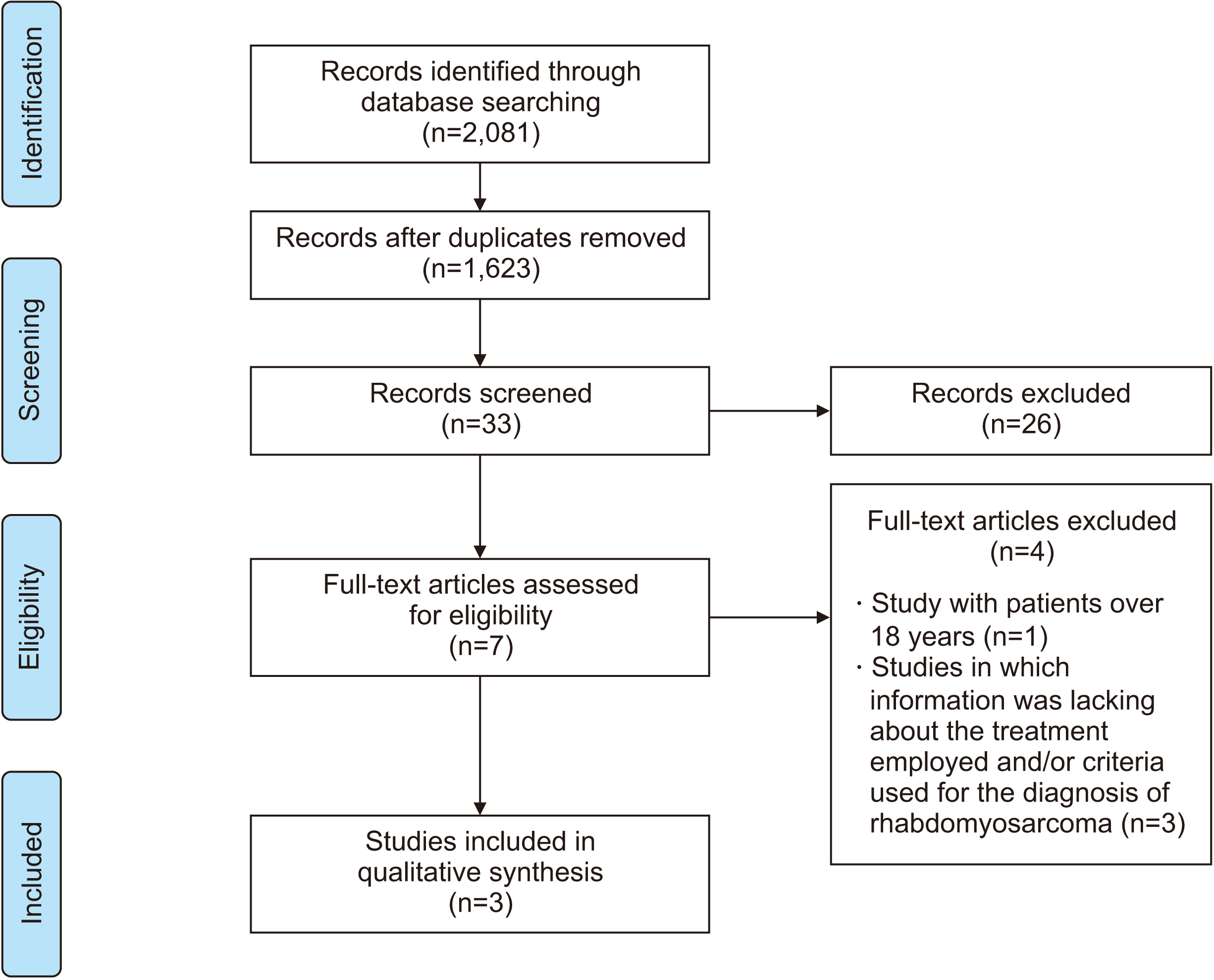J Korean Assoc Oral Maxillofac Surg.
2023 Apr;49(2):61-67. 10.5125/jkaoms.2023.49.2.61.
Clinical-pathologic profile of head and neck rhabdomyosarcoma in children: a systematic review
- Affiliations
-
- 1Department of Surgery, Stomatology, Pathology and Radiology, Bauru School of Dentistry, University of São Paulo, Bauru, Brazil
- 2Department of Pediatric Dentistry, Orthodontics, and Public Health, Bauru School of Dentistry, University of São Paulo, Bauru, Brazil
- KMID: 2542211
- DOI: http://doi.org/10.5125/jkaoms.2023.49.2.61
Abstract
- This systematic review aimed to analyze the clinicopathological profile and relevant prognostic factors of head and neck rhabdomyosarcoma in pediatric patients. The search was carried out in the electronic search portals PubMed, Lilacs, Embase, Scopus, and Web of Science. The search yielded studies that were then analyzed regarding study topic, data extraction, and risk of bias using the STROBE (Strengthening the Reporting of Observational Studies) guidelines. Finally, three studies were included for qualitative analysis. Most of the cases involved embryonic and alveolar rhabdomyosarcoma. Expression of MYOD1 was highly correlated with diagnosis of spindle cell/sclerosing rhabdomyosarcoma, which appears to have a poor prognosis in children. Furthermore, tumor size <5 cm and absence of metastasis accompanied by complete resection and administration of adjuvant therapies such as chemotherapy and radiotherapy favored a better prognosis.
Keyword
Figure
Reference
-
References
1. Zhang Y, Zhang WL, Huang DS, Wang YZ, Hu HM, Mei YY, et al. 2020; Prognostic factors in children with head and neck rhabdomyosarcoma: a 12-year retrospective study. Brain Behav. 10:e01697. https://doi.org/10.1002/brb3.1697. DOI: 10.1002/brb3.1697. PMID: 32548972. PMCID: PMC7428493.
Article2. Zhang WL, Zhang Y, Huang DS, Guo F, Han T, Hong L, Hu HM, Zhi T. 2013; Clinical character of pediatric head and neck rhabdomysarcomas: a 7-year retrospective study. Asian Pac J Cancer Prev. 14(7):4089–93. https://doi.org/10.7314/apjcp.2013.14.7.4089. DOI: 10.7314/APJCP.2013.14.7.4089. PMID: 23991958.
Article3. Yasui N, Yoshida A, Kawamoto H, Yonemori K, Hosono A, Kawai A. 2015; Clinicopathologic analysis of spindle cell/sclerosing rhabdomyosarcoma. Pediatr Blood Cancer. 62:1011–6. https://doi.org/10.1002/pbc.25367. DOI: 10.1002/pbc.25367. PMID: 25557260.
Article4. Rekhi B, Gupta C, Chinnaswamy G, Qureshi S, Vora T, Khanna N, et al. 2018; Clinicopathologic features of 300 rhabdomyosarcomas with emphasis upon differential expression of skeletal muscle specific markers in the various subtypes: a single institutional experience. Ann Diagn Pathol. 36:50–60. https://doi.org/10.1016/j.anndiagpath.2018.07.002. DOI: 10.1016/j.anndiagpath.2018.07.002. PMID: 30098515.
Article5. Zhu J, Zhang J, Tang G, Hu S, Zhou G, Liu Y, et al. 2014; Computed tomography and magnetic resonance imaging observations of rhabdomyosarcoma in the head and neck. Oncol Lett. 8:155–60. https://doi.org/10.3892/ol.2014.2094. DOI: 10.3892/ol.2014.2094. PMID: 24959237. PMCID: PMC4063592.
Article6. Schmidt D, Reimann O, Treuner J, Harms D. 1986; Cellular differentiation and prognosis in embryonal rhabdomyosarcoma. A report from the Cooperative Soft Tissue Sarcoma Study 1981 (CWS 81). Virchows Arch A Pathol Anat Histopathol. 409:183–94. https://doi.org/10.1007/bf00708327. DOI: 10.1007/BF00708327. PMID: 3012860.
Article7. Healy GB, Jaffe N, Cassady JR. 1979; Rhabdomyosarcoma of the head and neck: diagnosis and management. Head Neck Surg. 1:334–9. https://doi.org/10.1002/hed.2890010406. DOI: 10.1002/hed.2890010406. PMID: 500368.
Article8. Feldman BA. 1982; Rhabdomyosarcoma of the head and neck. Laryngoscope. 92:424–40. https://doi.org/10.1288/00005537-198204000-00013. DOI: 10.1288/00005537-198204000-00013. PMID: 7040870.
Article9. Lyos AT, Goepfert H, Luna MA, Jaffe N, Malpica A. 1996; Soft tissue sarcoma of the head and neck in children and adolescents. Cancer. 77:193–200. https://doi.org/10.1002/(sici)1097-0142(19960101)77:1%3C193::aid-cncr31%3E3.0.co;2-z. DOI: 10.1002/(SICI)1097-0142(19960101)77:1<193::AID-CNCR31>3.0.CO;2-Z. PMID: 8630930.
Article10. Meza JL, Anderson J, Pappo AS. Meyer WH; Children's Oncology Group. 2006; Analysis of prognostic factors in patients with nonmetastatic rhabdomyosarcoma treated on intergroup rhabdomyosarcoma studies III and IV: the Children's Oncology Group. J Clin Oncol. 24:3844–51. https://doi.org/10.1200/jco.2005.05.3801. DOI: 10.1200/JCO.2005.05.3801. PMID: 16921036.
Article11. Dillon P, Maurer H, Jenkins J, Krummel T, Parham D, Webber B, et al. 1992; A prospective study of nonrhabdomyosarcoma soft tissue sarcomas in the pediatric age group. J Pediatr Surg. 27:241–4. discussion 244–5. https://doi.org/10.1016/0022-3468(92)90320-7. DOI: 10.1016/0022-3468(92)90320-7. PMID: 1314309.
Article12. Radzikowska J, Kukwa W, Kukwa A, Czarnecka AM, Kawecki M, Lian F, et al. 2016; Management of pediatric head and neck rhabdomyosarcoma: a case-series of 36 patients. Oncol Lett. 12:3555–62. https://doi.org/10.3892/ol.2016.5072. DOI: 10.3892/ol.2016.5072. PMID: 27900036. PMCID: PMC5104052.
Article13. Häußler SM, Stromberger C, Olze H, Seifert G, Knopke S, Böttcher A. 2018; Head and neck rhabdomyosarcoma in children: a 20-year retrospective study at a tertiary referral center. J Cancer Res Clin Oncol. 144:371–9. https://doi.org/10.1007/s00432-017-2544-x. DOI: 10.1007/s00432-017-2544-x. PMID: 29143871.
Article14. Agaram NP, Chen CL, Zhang L, LaQuaglia MP, Wexler L, Antonescu CR. 2014; Recurrent MYOD1 mutations in pediatric and adult sclerosing and spindle cell rhabdomyosarcomas: evidence for a common pathogenesis. Genes Chromosomes Cancer. 53:779–87. https://doi.org/10.1002/gcc.22187. DOI: 10.1002/gcc.22187. PMID: 24824843. PMCID: PMC4108340.
Article15. Agaram NP, LaQuaglia MP, Alaggio R, Zhang L, Fujisawa Y, Ladanyi M, et al. 2019; MYOD1-mutant spindle cell and sclerosing rhabdomyosarcoma: an aggressive subtype irrespective of age. A reappraisal for molecular classification and risk stratification. Mod Pathol. 32:27–36. https://doi.org/10.1038/s41379-018-0120-9. DOI: 10.1038/s41379-018-0120-9. PMID: 30181563. PMCID: PMC6720105.
Article16. Badr MA, Al-Tonbary YA, Mansour AK, Hassan TH, Beshir MR, Darwish A, et al. 2012; Epidemiological characteristics and survival studies of rhabdomyosarcoma in East Egypt: a five-year multicenter study. ISRN Oncol. 2012:674523. https://doi.org/10.5402/2012/674523. DOI: 10.5402/2012/674523. PMID: 22675642. PMCID: PMC3362855.
Article


